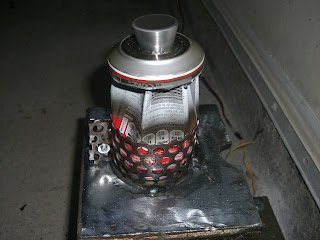miércoles, 3 de noviembre de 2010
Igniter & noozle test (Stage2 first burn)
English
In the last test we did the igniter decided to change the mode coupling the igniter with cable. In the other test we did was hook up the igniter "bare" (just the powder-filled bulb) inside the engine, seen the problems and the time it cost us to connect the cable to the igniter when to launch, we came up with the igniter with a 15 cm cable soldered to a connector at the other end, so we save time in preparation for takeoff, that we can release the igniter while we are trying to plug the cable into the rocket motor and cable as the cable is attached to the rocket burn, so it's better than blowing a 15-cm cable that does not have to go cutting a 150 cm. So we have a soldier igniter cord of 15 cm and epoxied to a motor amateur (for when we try) ready to be assembled in a rocket to be launched.
Test: Testing the "new" igniter, an amateur engine support for both tests and test a prototype nozzle. To this is to use a standard steel support where we are going to make a hole to pass the engine and we will weld a bracket to hold the can and it does not move, then we'll screw it to the ground (if case).
Test result: The igniter works perfectly, the engine is on and on for about 3 seconds, the can has a deformation.
Conclusions: At first we thought that the narrowing was an inplotion but later saw that no, due to heating of the can and push the nozzle, this is the shape of the can, in principle this is not a bad result because it shows that the nozzle works. The next step is to measure the nozzle thrust, that we'll make getting a hydraulic jack with a pressure sensor.
Castellano
En el último test que le hicimos al igniter decidimos cambiar el modo de acople del cable con el igniter. En los otros test lo que hacíamos era enganchar el igniter "pelado" (solo la bombilla llena de pólvora) en el interior del motor, vistos los problemas y el tiempo que nos costaba conectar el cable con el igniter a la hora de hacer el lanzamiento, se nos ocurrió crear el igniter con un cable de unos 15 cm ya soldado con un conector en el otro extremo, de esta manera nos ahorramos tiempo de preparación para el despegue, que se nos pueda desenganchar el igniter mientras estamos intentando conectar el cable dentro del motor del cohete y cable ya que el cable que va conectado al cohete se quema, así que es mejor que se queme un cable de 15 cm que no tener que ir cortando uno de 150 cm. Así pues tendremos un igniter soldado a un cable de 15 cm y pegado con resina a un motor amateur (para cuando hagamos pruebas) listo para ser ensamblado en un cohete y para ser lanzado.
Test: Probar el "nuevo" igniter, un soporte para motores amateur para hacer tests y a la vez probar un prototipo de tobera. Para esto se va a usar un soporte de acero estandarizado donde le vamos a hacer un agujero para que pase el motor y le vamos a soldar una abrazadera para sostener la lata y que no se mueva, luego vamos a atornillarlo al suelo (por si a caso)
Resultado del test: El igniter funciona perfectamente, el motor se enciende y esta encendido durante unos 3 segundos, la lata sufre una deformación.
Conclusiones: En un principio pensamos que el estrechamiento era una implosión pero que más tarde vimos que no, que debido al calentamiento de la lata y al empuje de la tobera, esta es la que deforma la lata, este en principio no es un mal resultado ya que nos demuestra que la tobera funciona. El siguiente paso es medir el empuje que nos da la tobera, esto lo vamos a conseguir poniendo un gato hidráulico con un sensor de presión.
Pictures (Fotos):
Picture #1
Picture #2
Picture #3
Picture #4
Picture #5
Picture #6
Picture #7
Picture #8
Suscribirse a:
Enviar comentarios (Atom)








No hay comentarios:
Publicar un comentario